Seasons Turn
Seasons turn swiftly in Bangladesh, like some other things. Last week I was enjoying the cool breezes of the end of winter on my skin. Yesterday it was suddenly hot.
In the farm, in just three weeks, the bald trees...
...had turned green...
... with leaves dripping color.
Of course the usual suspects still prowled.
But the bright yellow flowers of fall that had attracted so many critters...
... were gone, the dying plant now busy creating seedlings in place of flowers.
Even the ugly roadside plants...
...jumped into spring by producing pretty flowers.
The creepers of the forest were also out looking for some action.
But the best part of spring were these intensely fragrant Jambura blossoms. Thakur Mohashoi, "Fagune tor aamer boler ghraan" is not nearly as sweet-smelling as these, but somehow "Faguney tor jamburar boler ghraney" does not sound so poetic!
Friday, February 23, 2007
Bicycling Tour of Old Dhaka
I took seven bicycling friends (all expats) on a "guided" tour of old Dhaka today. We picked Friday to avoid traffic congestion.
The plan was to bicycle from Gulshan 2 to see old Dhaka sights. These are ordered to start in the southeast and end at the northwest.
1. Shakhari Bazar (aka Shakhari Patti)
2. Ruplal House
3. Pink Palace
4. Armenian Church
5. Bara Katara
6. Lalbagh Fort
7. (if time permits) Khan Mohammed Mridha's mosque
At the end of the tour our cars met us in front of Lalbagh Fort.
We started from Gulshan 2 at 7:15am and bicycled through Tejgaon industrial area, Maghbazar, Kakrail and turned into Najrul Islam road, made a left into Bangabandhu Avenue and then on to Nawabpur Road. Straightforward, but there were still a few busses on the road, specially near Maghbazar.
From Nawabpur Road we turned right into the road leading to Shakhari Patti, then walked our biycles. We looked through some open doors to see the narrow and deep houses of Shakhari Patti. Two monkeys entertained us perched on second floor verandas and windows. The triple-arch facade of an old house also attracted my friends' interest. But despite many requests I could not get anyone at Shakhari Patti to let us into a house and see the inside. Too early in the morning?
We bicycled out of SP and went around Bahadur Shah Park (after a quick briefing on 1857 Sepoy Revolution) by North Brook Road towards Farashganj. As we entered the spice trading area, we ran into a jam caused by trucks delivering wholesale spices and had to walk our bicycles. We found Ruplal House and admired its exterior.
RH is inhabited by families of Armed Forces, and at first they refused us permission to go inside. I tried to reason with the guards (the interior courtyard is very nice and gives one a sense of times past) to no avail. As we were turning around disappointed, they changed their mind and said ok, but strictly no photography.
After checking out RH, we crossed into the road that runs in front of the river (Lalkuthi Road) and bicycled towards Ahsan Manzil. Here I made a mistake. I kept going straight to show a nice view of Ahsan Manzil from Sadarghat Road. Should have turned right and taken Patuatuli Road instead, because the front of AM was a horrid, claustrophobic jam that lasted for several hundred feet. Trucks delivering wholesale fruits had blocked the road and zillions of people and Van Garis carrying smaller loads were also trying to move. It took us 15 minutes to cross this part, but my friends took this little adventure in good humor.
Then we went under the Buriganga bridge ramp and back into Islampur Road. Shortly we turned right towards the Armenian Church dating from 1781. The caretaker let us in and opened it up for us. It was a surprising island of tranquility - with memorials, one statue, and lots of green. We also went to the roof and enjoyed the scenery.
Onwards on Islampur Road, we headed towards Chawk Bazar where we turned left into a narrow alley to see Bara Katara, Dhaka's oldest building (1644), now the home of a Madrasah. After we viewed the exterior dome, a teacher graciously showed us inside and took us to the roof for some nice views. Inside the Katara, some rooms and passages looked really old - could be original.
After this we bicycled to Lalbagh Fort. Since we had time, we biked another half km and saw Khan Mohammed Mosque. This pretty mosque is build on a platform. The basement served - and still does - as a dormitory.
Back we came to Lalbagh Fort. My friends did not mind the differential in admission between Bangladeshi admission (Tk. 5) and foreigner admission (Tk. 50) - they were happy to pay it and hoped the money be used for upkeep. The grounds of the Fort were well-kept and beautiful. I overheard a boss type barking instructions to a gardener on how to prune and beautify the garden. We spent time around Pari Bibi's (Shaista Khan's daughter) Mausoleum. Then we headed to the Hammam Khana (no, not for a shower!) and the museum.
We finished at noon. My friends all enjoyed the trip. One commented that even though he had visited some of the same places before by car, the bicycle trip afforded him a level of immediacy not available in a car.
I am planning Part 2 of this trip. Let's see... Tara masjid, Goal Talab, Hossaini Dalan, Nurjahan House, what else???
Sunday, February 04, 2007
Brahmins and Naval Architects (Photos)
Last Friday we went for a 50-km bicycle ride out of Dhaka. It was a very foggy day: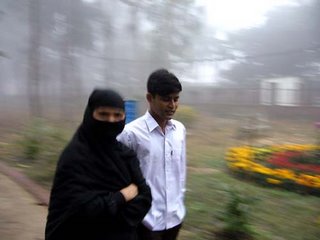
We biked east and then south of Dhaka, the last 5 km along the banks of the Sheetalakhya. This was my first time on that road. We spotted a shipbuilding yard on the bank and stopped to take a look. Workers were building a large, 200+ feet long ship.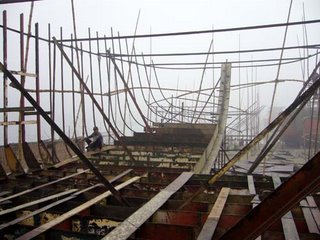
This gentleman is the owner of the operation. He said the metal comes from Chittagong, and is built into the ship which is sent back to Chittagong by river. Then it is used to move materiel between Chittagong and Dhaka. Takes about 8-9 months to make such a large ship. All the work is done on the premises.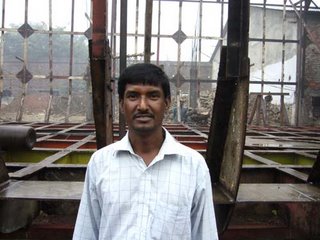
These two workers were painting the hull. They used a rag instead of paintbrushes to reach all the nooks and crannies (to seal them from rusting?)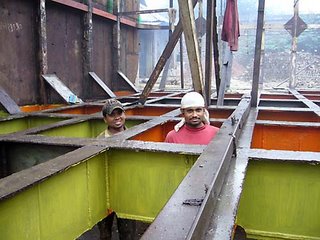
I asked them about Keraniganj, where I had seen large boat building facilities. They said it had shifted here due to people moving into Keraniganj area (gentrification.)
I hope to be back when they lower the boat onto the river. That should be quite a sight.
On our way back, Peter spotted some color at a distance from the road and we stopped to investigate. We walked to a field behind a village. It turned out a Hindu Puja - and an accompanying Mela - was in progress. It was called Purnima Puja or Dhamai(?) Puja. This priest was leading the prayers.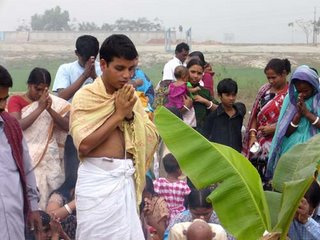
The air was festive, with music and drums.
The people praying were mostly women.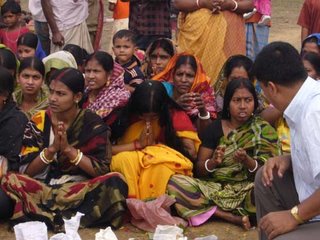
The mela offered toys for the kids.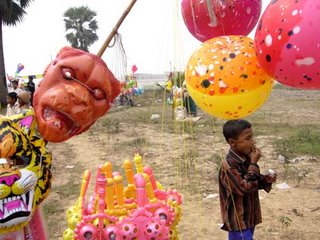
This gentleman asked me to take his picture with his granddaughter. I said I thought it was her daughter - he looked so young. He gave a hearty laugh.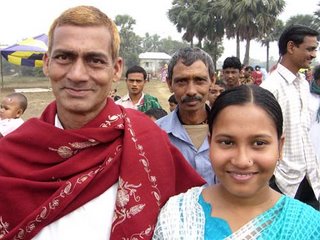
This girl had got her own balloon and was playing on the side by herself.
At night, it was full-moon, so indeed it was a Purnima. All in all, great day of exploring. Many thanks to my bicycling companions Peter and Mehreen.
Thursday, December 28, 2006
Travel Article on NYT
Many thanks to Satiprasad who pointed out this travel story on Bangladesh in NY Times. Nice to get the coverage.
Monday, December 11, 2006
Baikka Beel (Photos)
Baikka Beel is a wildlife sanctuary in the Hail Haor wetlands near Srimongol. It is a USAID-funded project. I bicycled there yesterday. Here are some pictures.
The sign on the main MoulviBazar-Srimongol road is to your right if you are coming from MB, about 0.5 km past Bhairabganj Bazar: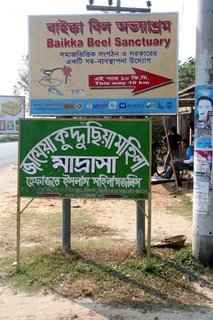
On the road I ran into fishermen returning from the haor with fish...
... as well as water buffaloes, whose milk is rich and flavorful...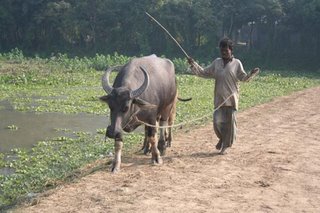
... not to mention grandma who was out shopping with granddaughter...
...but this horseman was a surprise.
After about an hour of cycling from the main road, there was this explanatory sign...
...and an observation tower with incredible views from the top.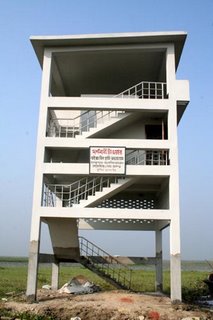
On the tower, Ujjol - one of the caretakers - points out some birds...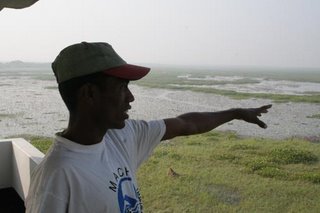
... of which there were thousands...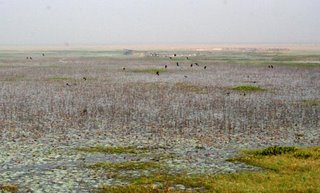
...and thousands.
Another view from the tower...
As I started back I saw the field was full of cobwebs reflecting morning light.
An excellent morning of exploration. My thanks to the sponsors and organizers of this project, which provides sanctuary for 98 types of fish and 160 types of birds. I will certainly visit it again, Inshallah.
Tuesday, December 05, 2006
What Does Catman Do?
Years ago when I was new to Unix, I was having trouble understanding the man page for "catman" command. So I asked another engineer, Steve, "What does catman do?" and he said, "It is the capital of Nepal." Heh heh.
Last week I visited Kathmandu for the first time to accompany my son's school basketball team - my son plays in that team - competing in a regional tournament. They won the championship competing against schools from Delhi, Kathmandu, Colombo, Bombay, Lahore, Karachi, Islamabad and Murree. Congrats Tigers!
Kathmandu was interesting, but also raised troubling questions. They have a huge tourism industry, but where do the tourist dollars go? Talking to some locals, I got the impression the people are very poor. But incredibly nice, friendly and they liked Bangladesh a lot. A lawyer I met during lunch at a local hole-in-the-wall told me that the years of Maoist insurgency had really drained the economy.
I was in KTM the whole time, but if you go on a trek, for $30-$50/day/person you get guide+porter, lodging at "tea houses" and food. What kind of food? The guide shows you a menu and you choose what you want to eat and they cook or order it for you. Wow! Luxury in the mountains. Far cry from the gorp-and-freeze-dried sustenance I endured while backpacking in the Sierra Nevada.
Here is what really bugs me. So these mountains are their country. Yet, the poor Nepalese do the grunt work while foreign tourists explore the mountains like lords. Hardly seems fair, does it?
Wednesday, November 15, 2006
Old Dhaka Gems (Photos)
I am beginning to really like old Dhaka. The city reveals many gems once you look beneath the veneer of crowds and dirt. Like Rome, you might turn a corner and find yourself face to face with a really old building (ok, ok, so Roman buildings are a wee little bit older...)
Tara Masjid in Bangsal was the most exquisitely building I found. Parts of it are 200+ years old, though it was renovated in 1987. Here are three pictures of it.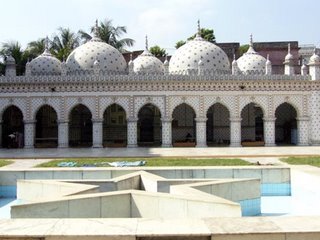
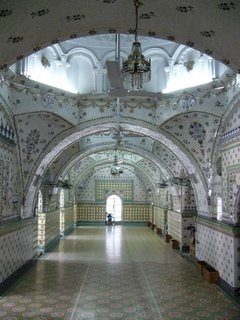

Armenian Church goes back to 1781. It was built during Dhaka's heydays when many European merchants came here looking for business and their fortunes. It is locally known as "khristan bari". Here are three pictures.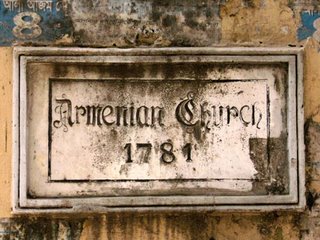

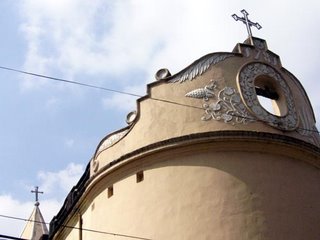
Ruplal House is a grand 19th century mansion built by Mr Ruplal, a businessman. Today it houses some businesses as well as Army folks.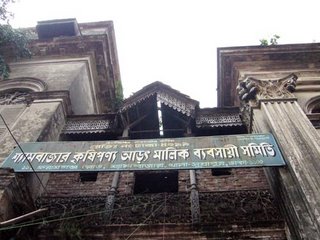
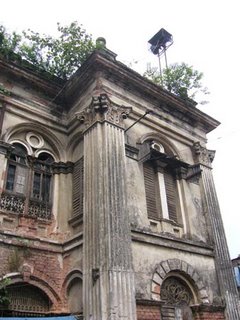

Khan Mohammed Mridha's mosque dates back to 1706. It is built on a raised platform. On the bottom floor, below the mosque platform, are dorm rooms where students live. The third picture is the hallway connecting these rooms.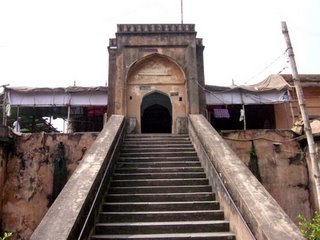
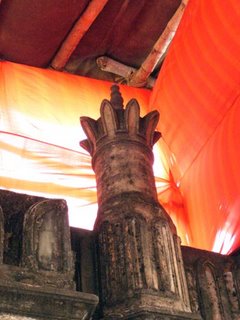
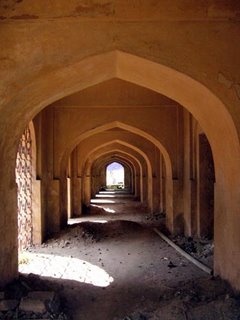
Here are some pictures of Shakhari Patti. Shakharis are (Hindu) craftsmen who make ornaments from Shakha (conch shells). They came here over 300 years ago. This area is known for the very long and narrow houses (the second picture shows one such narrow house.) The third picture shows an abandoned building with the trademark triple-arch that is common to old Shakhari Patti houses.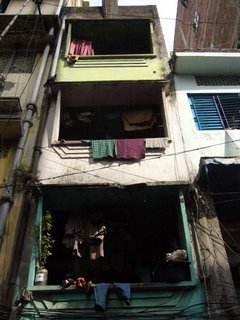
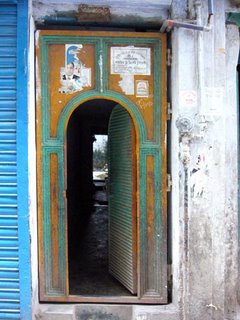
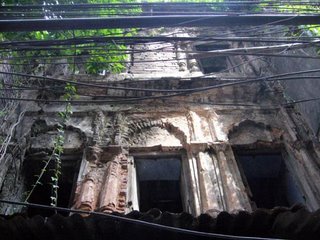
A picture of Lalbagh Fort, which was built in 1678 by Prince Azam, the third son of Aurangzeb.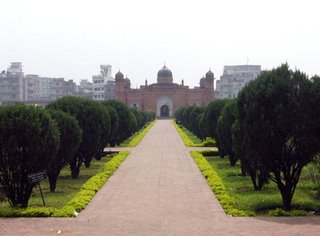
How can I not include the Pink Palace, aka Ahsan Manzil? Built in 1872 by Nawab Ahsanullah, renovated recently. I am not crazy about the color, but I am glad they put in the effort into renovation.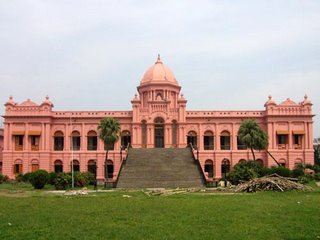
Tuesday, November 07, 2006
Dhamrai Metal Craft (Photos)
Dhamrai is famous for its handicraft work. It is about 25 km from Dhaka and takes between 1.5 to 2 hours by bus from Asad Gate. From the bus stop you take a rickshaw to Dhamrai Bazar.
Sukanta Vanik, who owns Sukanta's Dhamrai Metal Crafts. His family has worked in metalcraft for 200 years.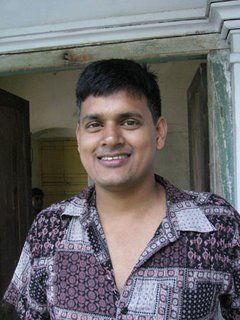
To make a metallic object of art, the worker starts with wax..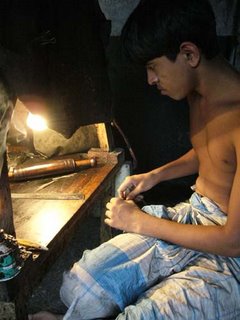
...which is painstakingly rolled and cut...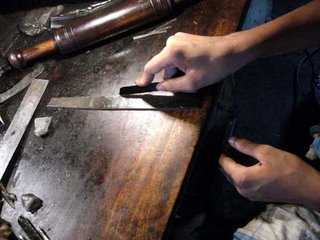
... to make a replica of the object
A worker then covers this with a special type of mud...
...so the wax replicas look like this.
These are baked in this oven which melts the wax and hardens the mud into a mold:
Finally molten metal is poured into the mold to make the finished product:

Some of the art can take 5-6 months of work. I saw an exquisite merry-go-round of horses, about a foot in diameter, priced at Tk. 18000.
I saw many types of craft around Dhamrai Bazar, such as making Dhols (drums).
Many thanks to my friend Zahed for being guide.
Wednesday, October 18, 2006
Bicycling Tips for Dhaka
I have finally gotten the hang of bicycling on Dhaka streets. Here are some guidelines I find useful.
Since Dhaka streets are prone to traffic jams, it is best to be flexible about destinations and times. Even better, try not to have a destination at all. Because if you have a firm destination in mind, then all other cars, busses, trucks, CNGs, rickshaws, motorcycles and pedestrians will simultaneously decide to go to the same place. Thus none of you will get there in the foreseeable future.
For bicycling purposes, street and footpath are interchangeable. In fact, footpath is preferable. Think about it. Unlike a nasty "Tata Mahindra" bus, no matter how hard a pedestrian runs into you, or you into them, they cannot crush your bones.
Also, using the footpath makes you adaptible. If your progress towards unknown destination stops due to a jam, you can keep moving by switching to a footpath.
Always wear a helmet. This will make sure you get the attention you deserve. Note however people are not staring in admiration of your impeccable safety standards. They are wondering how mad you are to be wearing this gizmo on your head on a hot day as sweat streams down the sides of your face.
Wear those zip-off-leg pants. Then open the front of the zip so your knee pops in and out in sync with pedaling. This provides much-needed air- conditioning your body. Also, those wondering about your sanity will stop wondering and avoid you.
Use a bell liberally. The soothing sound provides a musical counterpoint to the ongoing concerto for car and bus horns. The preferable spot to use the bell is on the footpath, when you are right behind a pedestrian. As a bonus, you will see their jumping and dancing skills.
For safety, use buffers when crossing or turning in insanely busy streets or roundabouts. Buffers are other pedestrians, bicycles and rickshaws which are crossing the street at the same place as you, but are closer to the approaching traffic. So if busses are coming from your left, your buffers should be crossing the street on your left. Thus, if a runaway bus cannot stop in time for your crossing, hopefully the collision with your buffer will stop it before it hits you.
Although it is sometimes tempting to go slow and savor the noise and fumes - I mean, peace and greenery - try to maintain a good pace. There is nothing more embarrassing than being left in the dust by a thin rickshaw-wallah carrying two overweight parents and a kid while you amble away on your fancy foreign made bicycle wearing that helmet.
Speaking of rickshaws, another great way to make friends with them is to follow one carrying many jute sacks full of rice. At an opportune moment - eg, when it is taking a turn and its balance is compromised - rear-end it firmly. Be sure you have a quick escape route before attempting this maneuver. Observe avalanche of the sacks from a safe distance.
If traffic heading in your opposite direction is completely stopped while you are breezing along, you can make many more friends my smiling and waving at the stuck people as you pass them. Loudly sing "Pichdhala ei pothTare Bhalobeshechhi" for extra effect. (Translation: Oh how I love this paved road!)
Us Banglas take our expectoration seriously. Try to anticipate when a person near you is going to spit, clear phlegm or throw pik (the red stuff resulting from chewing betel leaf) and which direction they will aim. Sometimes you will hear a throaty warning signal, but they can also strike silently. Avoid being in the same spot at the same time as flying expectorant.
Along the same lines, exercise caution when near a bus - specially a long distance one with open windows. Sooner or later someone will hurl through a window. Try not to get any on yourself. Double decker busses are even more dangerous. Aren't you glad you are wearing that helmet?
Never assume that just because you are on the left side of the road, other vehicles on the same side are headed in the same direction. Every 11th bicycle, 14th rickshaw and 7th motorcycle is headed wrong-way. No, they did not spend many years in America and think it is ok to drive on the right side. Actually I don't know why they do it - for shortcut purposes?
Be extra careful around traffic policemen with big sticks. They can become excited unexpectedly. Excited traffic police swing their sticks wildly. Try not to get your nose smashed in.
Delay your normal morning shower until after the bike ride. If you need a grey shirt, wear a white shirt during your ride and find an older bus spewing out black smoke. Follow this bus for a few minutes.
When you are getting tired of waiting to cross the road, never underestimate the power of stepping in forcefully in front of a moving vehicle. This is the only way to make them stop. Hopefully the buffer you have kept on your left will help. But if not, be brave. And if the vehicle doesn't stop - hey, you did leave your life insurance policy with your SO before leaving home, didn't you?
Friday, August 25, 2006
Khilkhet Bicycle Ride (Photos)
I went on a 4-hour bicycle trip through Rupganj, east of Khilkhet, with my biking buddies today.
Crossing Basundhara housing we took a small boat (chhip nouka) across the water to get to Khilkhet proper (this let us avoid Airport Road). The boat was small and shaky, and it took two trips for the three of us with our bicycles.
We biked past at least half a dozen new "cities" being developed (Jamuna City plus others.) There was major land reclamation going on, with sand - dredged from under the Padma and brought here in large boats - being pumped from those boats via fat pipes into the desired locations. This sand is used to raise the level of the land; if you look at Dhaka using Google Earth you can see the bright white sand patches in the northeast part of town.
On these bicycling trips, since I wear a helmet and western garb, and am out with the "foreigners", most people don't think I am Bangladeshi - until I wish them a Salam or ask "Kemon Achhen?" at which point they turn to their neighbor with a surprised expression, saying "oiTato Bangla, dekhsen?" (apparently "Bangla" has become short for "Bangladeshi.")
I bantered with many people in this way. Then it was my turn to be surprised. We were coming down from a bridge heading towards a bunch of kids who were watching us. I guess they were arguing whether I was a Bangladeshi, because as I passed by one of them yelled at me in Bangla, "tire-er pump gesey ga" (your tires are deflating) and I immediately looked at my tires. This of course resolved their argument; they laughed and clapped and one of them said to the others: "Koisilam na oiTa Bangla!" ("Didn't I tell you he is a Bangladeshi?")
We stopped for a tea break at a village called Moshur. Acting as interpreter for my friends' questions, I asked the villagers if the lack of rain had affected their crops. No they said, because they plant a variation of IRRI rice that is planted in Kartik (September) so the rains are not critical for it. In fact, their sugar cane harvest was good this year because of low rains. The rice, once ready, will sell for Tk10/kg (unhusked). Per acre they expect about 95 Maunds of unhusked rice (1 Maund =40kg).
What else do they grow? "We have fisheries over there where we grow Shorputi, Rui, Carp and Tilapia." And no Pangas, I asked. "Nope, Pangas is cheap and yields no profit."
In another village a babytaxi with mike went around announcing "Great news, great news, on Saturday from 10am-3pm, mothers will get free health checkups for their children at such and such place."
Some pictures:
Shaplas have started to bloom. They come in many shades including white...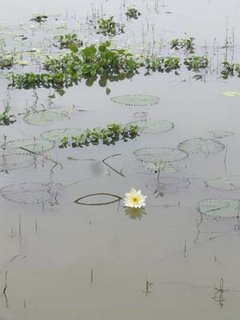
and pink:
A good season for fishing, either with a borshi (fishing pole)...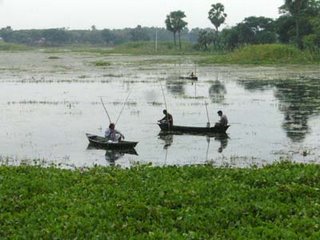
...or with nets: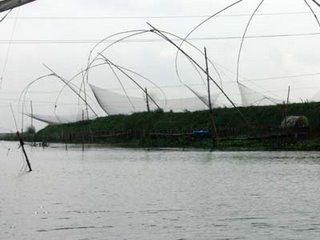
Dugout boat made from tree-trunk: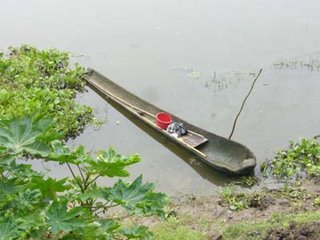
Two friends who were walking down the street near Moshuri: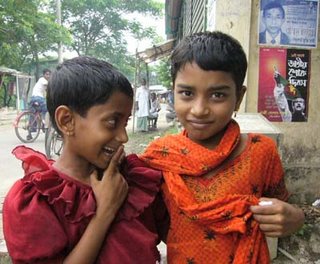
Photography studio at Moshuri:
The mom wasn't sure about being photographed but the child did not mind: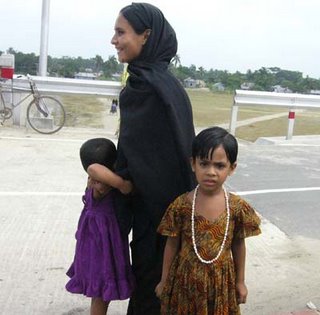
Joyride bus:
Many thanks to Stefan and Peter for giving me company on this trip.
Monday, August 14, 2006
View From the Train (Photos)
I took the train from Dhaka to Srimongol last Saturday. I saw these from my window:
My train was called "Parabat Express":
Man walking cows to the field: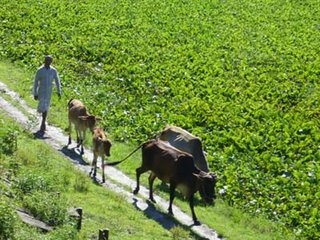
Farmers transplanting rice seedlings; harvest in Aghrahayan:
Typical river scene: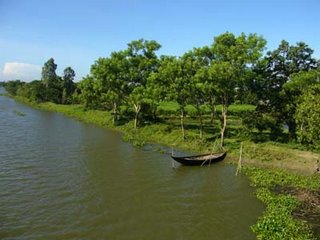
Tea garden:
Decorated gate for a village wedding:
Flags supporting world cup soccer:
An Uros party (celebrating the death anniversary of a local saint):
Boats of Bedey people (who live their lives on boats):
Man building a temporary home:
Fishing net being dried in the sun:
Helping get water out of a boat: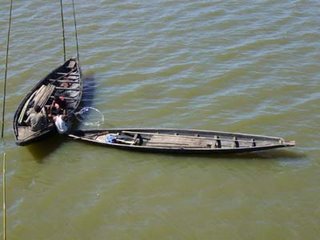
Mother and daughter at a train station in the (hot) noonday sun: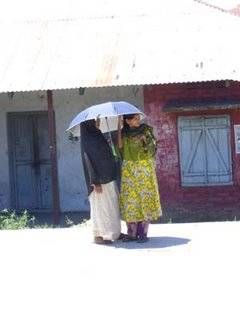
Train going the opposite direction: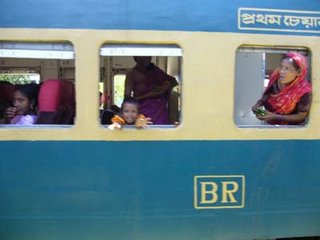
People on the roof: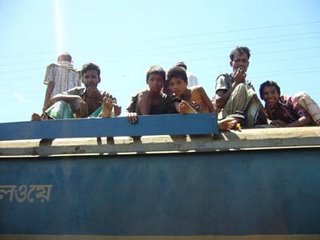
Girl on tracks: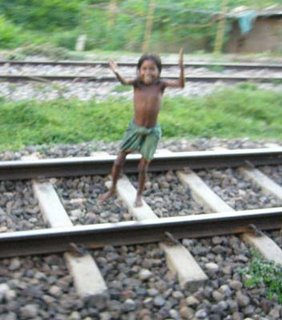
Note: this was a First Class seat. A/C Class windows are fixed shut and will not offer these views. Trip was 4.5 hours.
Friday, August 04, 2006
Srimongol Bike Ride (Photos)
Yesterday I went for a 40-mile bike ride through the tea gardens in Srimongol. With me was Stefan (a biking buddy) who planned this trip and came prepared with an older edition of Lonely Planet Bangladesh with a map of this area (the current edition does not.) We started out in Kamalganj and biked in a loop through many tea estates including Srigobindapur, Dolai, Balicchera, Husseinabad and Phulbari.
The starting point for this loop was the HEED bungalow in Kamalganj. From there we followed the main road towards Shamshernagar until reaching a large intersection, where we turned right. Then we pretty much followed this road all the way, looping through various gardens and emerging on the main road again near Srimongol.
The road varied from paved to brick to sand. We did not encounter significant mud despite the rainy season.
It was a daytrip from Dhaka. Left Dhaka by car: 6:30am; arrived at Kamalganj: 9:30am; done biking: 3:30pm; left for Dhaka by car: 4pm; arrived home: 8:30pm.
It was beautiful in a serene, peaceful kind of way. Here are some pictures. Many thanks to Stefan for taking the initiative for the trip and navigating.
We ran into some spectacular landscapes. In the distance it was raining, but we luckily managed to stay dry:
The path was pretty though the brick portions of it jarred every bone in my body!
Many people used biycles in the villages. The boy in the foreground is too small to sit on the saddle but can ride by threading his leg through the frame's triangle. Later we met two boys who had bicycled from Shamshernagar to Srimongol (19km) for fun.
Once we lost our way and ran into these kids in a village...
... and then this Mohish (water buffalo) with whom I was very careful not to get into an argument!
School was over near Srigobindopur:
This father and son pair were working in the tea field: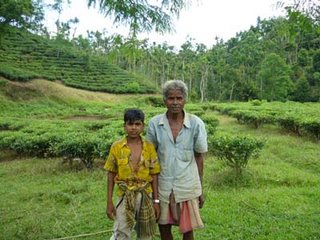
In the garden, women waited to weigh the tea they had collected. Life must be hard when so much of it depends on weight - be it tea-leaves, rubber-latex, fruits, firewood or fish.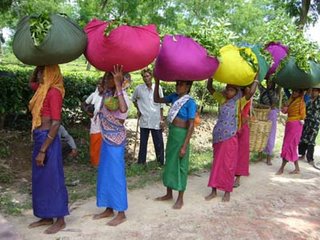
Other workers got a lunch break...
...While a boy offered guavas for sale near a labor village.
On a mandap at the foot of a large tree were remains of a prayer offering: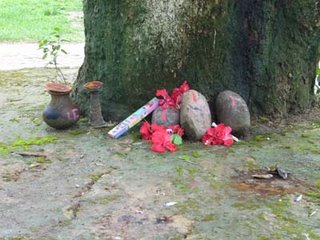
A drying sari lit up the landscape...
... as did this group who had just finished their weighing: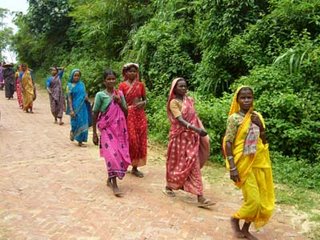
Meanwhile, it was time for the Friday shave for one of the men -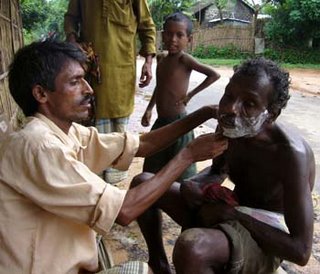
...but - as usual - the children had a better idea!
Postscript: Several years ago, I photographed the tea workers extensively. You can see some of them in my photo exhibit at the Fixing Shadows online Gallery, for example, this girl
Friday, July 21, 2006
Bara Katra, Chhota Katra (Photos)
Bara Katra is one of Dhaka's oldest buildings, built in 1644 by Mir Abdul Qasem. It was originally an enclosed quadrangle on the Buri Ganga, with a marvellous entrance/gate with four wings and 22 rooms. The remains include the entrance and the tower. In a sad an delapidated state, one needs to use one's imagination to visualize the grandeur that this place must have held.
Here is the front of the entrance: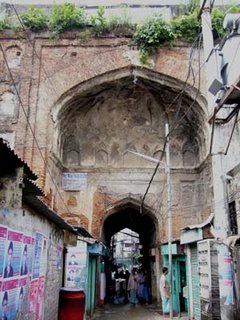
and the rear:
The tower:
Back side of the edifice:
Underside of the archway with decorations:
Living quarters under the archway. The archway also contained a few stores.
Inside Bara Katra is a Madrasa now. A kind man showed me around. Interior views:

Stairs inside Bara Katra:
Chhota Katra was built by Shaista Khan in 1663. D'Oyly mentions it in his "Antiquities of Dhaka." It is similar to Bara Katra, but even less remains.
Entrance of Chhota Katra:
Inside Chhota Katra was an umbrella-making shop with these walls: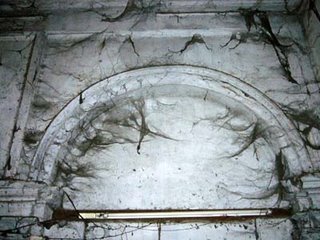
View from top of Chhota Katra looking to the river:
Having recently visited Italy and seen the amount of tourist revenue they must get out of old monuments, I am convinced that if we take steps to save/restore these monuments, our investment will be paid back many times. Why is it that we so easily let our irreplaceable buildings slide to destruction?
I got the historical facts from "Discover the Monuments of Bangladesh" by Dr. Nazimuddin Ahmed, published by UPL.
Friday Morning in Old Dhaka (Photos)
Feeling inspired by the adventures of Mr Islam and Ms Mustoe, I took advantage of Friday morning's light traffic to bike to old Dhaka and check out Bara Katra/Chhota Katra.
On the way I ran into this life-size sculpture on Shaheed Tajuddin Rd, made entirely from rickshaw/bicycle chains:
When I reached old Dhaka, the stores were all closed, including the famous Haji's Biriyani House on Alauddin Road. It has no signs, but twice a day people line up to buy the delicious biriyani cooked in mustard oil: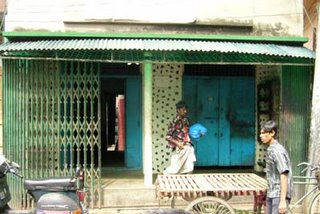
Life, however, went on. Friday luxuries included a visit to the barbershop...
...and getting the ears cleaned.
And don't forget shoes need polishing too:
A man in front of a closed store sold colorful children's clothes...
...And a girl was out wearing her "Friday best"
I had to share the road with all manners of vehicles!
The sky grew dark and in minutes there was a torrential downpour. I got shelter, but this rickshawallah did not get a break.
After the rain cleared, kids came out to play soccer on the wet street.
The fresh mud was no deterrant for a good tumble!
I went on to my destination. Details and photos in the next posting.
Saturday, July 08, 2006
Bangladeshis in Italy
Last month, a 20-year dream came true: we visited Italy. While it was an amazing lesson in history, I was also taken by surprise at the Bangladeshis in Italy.
I heard estimates of between 200,000 and 600,000 Bangladeshis in Italy.
I saw them in Rome, Florence and Venice (but not in Siena.) The ones I saw all had small to medium-size businesses. In Rome, they were selling handbags, sunglasses and tourist material on the streets. In Florence, we walked into a store selling "Indian-looking" things - "monohori dokan" - only to find the owner was a Bangladeshi who had a chain of these stores in the city.
In Venice, they were selling trinkets - like little puppets made from balloons - on the Accademia bridge and in San Marco Square. The seller told me these would not sell in Rome, but in Venice the tourists buy them.
They were incredibly kind and polite to us. The person in Florence - much to our protestations - fed us Cokes and ice cream, and sold things to us at large discounts. When it came to prices, they said "Pay us what you want - we are so happy to see a Bangladeshi tourist here." It was a kind of haggling in reverse. One street vendor in Rome, after selling a sunglass at 18 Euro to an European person, turned around and sold me a similar sunglass at 4.5 Euro. I wanted to pay him more, but, incredible as it seems, he would not take it. I think this covered his cost, barely.
At a mini-flea-market of Bangladeshi stalls at the Tiburtina station in Rome, I fell into a discussion of the business. It costs them 1000-2000 Euros a month to rent each stall. The work is very hard, and they live frugally. So they are able to save some money which they send home. One seller in Venice said he can save up to Euro 1000 a month, but only if a lot of conditions are met (eg, he has to sell an average of 50 euros' worth daily; his food expenses cannot exceed Euro 80/month, etc etc.)
I was inspired by their entrepreneurship and touched by their generosity and hope their dreams come true soon.
Here is a stall at the mini-flea-market outside Tiburtina: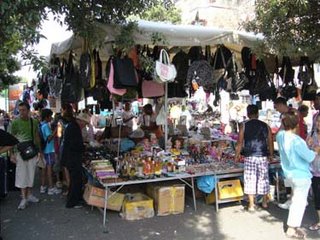
Sunday, June 04, 2006
Bangladesh: The Sleeping Beauty
Nice article in The Independent of UK:
http://travel.independent.co.uk/asia/article355274.ece
"... We reflected on why so little had been done to preserve the country's heritage."
Yes indeed.
Monday, May 29, 2006
Sunday, May 28, 2006
Interesting People in London
During my visit to London, I "ran into" some interesting people.
I was walking by a bookstore on the way to a meeting, when I saw a sign saying Pele, the legendary footballer, would be book-signing at 6PM Thursday. It took me a couple of moments to realize it was Thursday and very close to 6. I am no closet Paparazzi, but I was not about to pass up on a Pele sighting.
Here is the picture I got (you can see I failed the Paparazzi test :-)). But it was great to see this legend: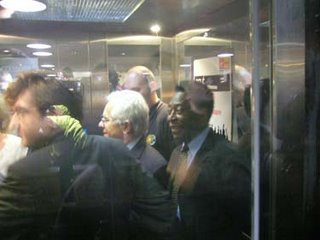
Weirder, here was a guy in the crowd who looked exactly like Scott McNealy!
Another time our delegation was invited to a dinner. The guest speaker was the Queen's son, Andrew, the Duke of York (Fergie's ex):
This was the place setting for the dinner. Over the top, but hey it is royalty!
In his speech, Andrew went to bat for the British IT industry, urging the invited foreign businessmen to do business with UK companies. Perhaps more Bangladeshi leaders can do the same for the IT industry here?
Bangladeshis in London
I lived in London from 1975 to 1977. Those were dark days for Bangladeshis (indeed, all immigrants) in London. Racism was rampant and economically the Bangladeshis inhabited the bottom of the food chain.
Two weeks ago I visited London as part of a business delegation. I had some meetings in Brick Lane and got to re-visit some of the "slums" I remembered from earlier days. Boy have things changed!
Bangladeshis (specially 2nd and 3rd generation) are now an upwardly-mobile group in the UK. Brick Lane thrives with rushing young people running their own businesses.
Not only do Bangladeshis own over 20000 restaurants in the UK, they sometimes co-opt other cuisine and give it a Bangladeshi taste. Eg, "Perfect Fried Chicken", a Bangladeshi-owned chain, takes the traditional Doner Kabab (Gyros) and fries it with chilis and Bengali spices to turn out a Bangladeshi Doner Kabab. I thought a good Doner Kabab could not be improved but these guys proved me wrong.
Bangladeshis hold many high-profile positions in the UK. For example, Irene Khan, the chief of Amnesty International, is from Bangladesh. So is the new mayor of Tower Hamlet Borough. The Qureshi family is probably a record-breaker in having three elected officials, called "Councillors", in London. And of course, Anwar Choudhury, the British High Commissioner in Dhaka.
In the (rather fat) book "Probashir Katha", Nurul Islam chronicles how the Bangladeshis - most of them from Sylhet - arrived in the UK. For example, Bangladeshi sailors fought alongside the British in the First world war and are mentioned in War Memorials in London. During the 1970s, several Bangladeshis were killed in racist violence.
But the persistence of this community - particularly in educating their younger generations - has paid off. I congratulate them on their success.
A signpost on Tower Bridge pointing to Banglatown:
A park in memory of Altab Ali, killed by racists in 1978: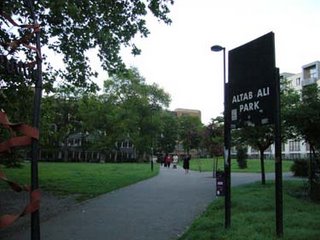
Wednesday, May 10, 2006
Driving in Dhaka
During my first few weeks in Dhaka, I was constantly stressed by the driving. I mostly relied on a driver, but was worried he was going to hit someone or something. Amazingly, nowadays I am relaxed in the car.
Some unwritten rules I have gathered (remember, you drive on the left here):
If you are at an intersection and want to turn right, it is best to be on the leftmost lane and swerve all the way to the right at the last possible moment. This helps keep everyone awake and provides free brake-check for parties on the right.
Rickshawallahs will not brake unless faced with a situation where the cost of not braking is significantly higher than the cost of braking. One such situation is a policeman with a big stick. Impending collision with a speeding car does not constitute a reason for a rickshawallah to brake. After all, it is easy for the car driver to brake and resume, but it is much harder for the rickshawallah to do that.
If you are a CNG driver, then the amount of arrogance you show while saying "No" to a prospective passenger's trip request should be directly proportional to how exhausted/sweaty/pitiful the passenger looks.
If you are a bus driver, nothing will dare get in your way. Do as you please.
Honking is an act of courtesy. You should honk whenever there is the remotest chance that the person (or vehicle) in front of you is unaware of you. Sometimes you should honk to make sure your horn is working. You should do this preferably between 2am and 4am.
If you are near a pedestrian overpass, you should be really watchful for pedestrians. Whenever they see an overpass, Bangladeshis have the curious need to cross the road. Since it is easier to dash in front of speeding cars and jump over traffic islands than it is to climb the overpass, most people will opt to get in the way of your car. The govt should have built overpasses for the cars at major pedestrian intersections in order to save the pedestrians so much inconvenience.
courtesy by...
SAGAR RESTUARANT
 |
Sagar Restaurant offers an extensive choice We provide 100% halal meat.of traditional Bangladeshi, Pakistani and Indian cuisine together with new mouthwatering recipes, but if you have a preferred dish that isn't on the menu, please don't hesitate to ask the management who will be more than happy to have our chef specially prepare it for you. |
Jamaica, New York 11432
PHONE: 718-298-5696
718-657-2855
718-213-4338(for catering only)
Web Site: www.sagarfood.com










